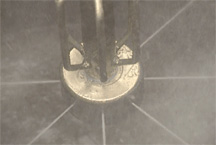
Hydrofracturing | Jetting (water/air) | Frac-Packers™ | Tools
 |
|
| RTT-Rig
Tender® | WFT-Well
Frac™ | Well Rehabilitation | RBT-Rig
Buddy™ Hydrofracturing | Jetting (water/air) | Frac-Packers™ | Tools |
| Hydrofracturing | ||||
Hydrofracturing
is a water well development/rehabilitation method used to increase the
yields of low-production water wells completed in rock where the fracture/joint
systems are so poorly developed or so tight that little or no water can
move through them. |
|
|||
|
|
are
primarily for domestic use with some applications in 8" & 10"
wells for commercial, industrial and municipal uses. The most common geology
found in wells that are hydrofractured, is basement igneous type rocks
such as gabbros, granites, schists, etc. There are some areas where shales
and slates predominate as well as others with limestone and sandstone.
Most "fracturing" occurs between 1,000 to 2,500 psi in hard
rocks and 300 to 800 psi in softer rocks. The most common pumping flow
rates are between 65 and 120 gallons per minute. Propants to keep fractures
open; such as sand, glass beads, etc., were experimented with early on
in development but now are seldom used because of their uncertain benefit,
if any. |
|||
| The
areas in the United States where this method of well regeneration is used
the greatest include the upper 1/3 of the country and scattered mountain
areas throughout the states. Around the world, this |
||||
equipment
and these methods are being sucessfully applied in India, Africa, South
Korea, New Zealand and parts of the Far East. In the US, the success rate
is generally acknowledged to be 95% where the production of the well has
been at least doubled. Four to five times of the original production is
quite common with some spectacular results in the neighborhood of 50 times
the original production. There is no clear pattern of success however,
and the results can often times be confusing. This is becasue of the lack
of direct correlation between fracture pressures and production, fracture
pump flow rates and production, and the results from encountering nearly
identical conditions with vastly different results. |
 Water Jetting |
|||
Hydrofracturing
is accomplished by lowering a borehole packer into a water well and
expanding it ("setting") below the casing depth/static level
and above the fracture/joint system. This isolates the potential production
zone from the rest of the well. Water is then pumped down through the
water injection pipe at high-pressure and high-volume simultaneously.
The pressure and flow created in the production zone usually causes
small, tight fractures/joints in the rock to open up and spread radially.
The newly opened and flushed out fractures provide connections between
nearby water-bearing fractures and the borehole. |
||||
provide
"screened" well development, clean-out, and redevelopment
with the addition of more tooling. High
pressure jetting devices, with interchangeable SS nozzle inserts to match
your pump, can be very usefull in all drilling operations - for both new
wells and reworks. It is also a good practice to clean the walls of the
borehole before any hydrofracturing is performed on the well so that any
loose material such as sediments, rock flour, bio-fouling, drill cuttings
or mineral deposits can be dislodged and then pumped out of the well.
This method is highly effective in making hydrofracturing more successfull
by removing debris that may block the effectivness of the injection of
high-pressure, high-volume water. Hydrofracturing has proven higly effective at increasing water production, increasing water storage, improving reliability and reducing suspended sediment in water wells. Success rates, as measures by yield improvements of at least 100%, have averaged between 70% to 95% around the world, depending on geology, water pumped, well construction and experience of operator. |
||||